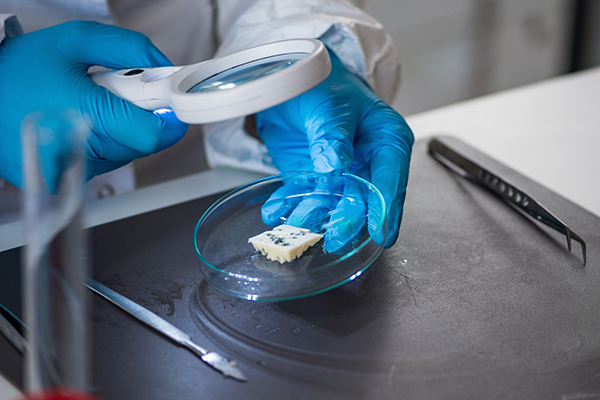Food Safety Considerations for the “New Way” of Dining, Part II – Back-of-house
In our first blog this month, we discussed the importance of front-of-house practices as we emerge from the pandemic this summer and into fall. Making your guests feel safe will be an important point as we welcome them back to our establishment. The safer they feel, the more likely they are to revisit and this could, in turn, be a competitive advantage for your business.
For this blog, I’d like to focus on more of what we might do in back-of-house operations. Frankly, this is a much harder blog to write, because most foodservice operations already have a solid food safety program and most of these common food safety practices will help protect our guests and ourselves from the Coronavirus. But, as we emerge from the pandemic and business hopefully begins to increase, some considerations:
Remind your staff, front- and back-of-house staff alike, that nothing is so important it can’t be done safely. Making your guests feel safe when they are emerging from a time when nothing felt safe is more important now than ever before.
- Handwashing. Handwashing is always an important issue and remains vital. Whenever we have done onsite observations in any of our research studies, handwashing remains problematic. In one of our studies[1], all handwashing compliance rates were less than 50%, the most problematic being washing hands after touching clothing or an apron that was soiled – with an in-compliance rate less than 1%. Often crisis situations are disrupters and can help change habits. Use this pandemic as a disrupter. Proper and frequent handwashing can have significant impact on overall health and safety in your establishment, so as you work to improve practices, make sure you don’t overlook the basics.
- Increased Demand. As we emerge from the pandemic, I would expect in-house dining to begin to increase. What I am not so sure about is how this may (or will) impact to-go or carryout dining, which has been the backbone for many operations during the pandemic. Begin to outline a strategy, including the overall flow of food and help needed to support a full restaurant along with increased to-go traffic. If demand for both remain high, it is a great way to pull in additional revenue without needing increased dining space, but we need to have a plan to accommodate and support both within our kitchen, without burning out our staff.
- Reconsider Packaging. As we emerge from the pandemic and our suppliers are able to stock items which may have been limited during the pandemic, now would be a good time to reassess to-go and carryout packaging. For many years, these items were a second thought. But, in the last 10 years, operators have started to focus on these a bit more. In light of the increased demand we now have for these items, be sure the packaging you select is sustainable, presents your food as you wish, and helps to maintain proper temperature. While the latter is difficult, if you are using a third-party delivery service, remember the time it takes to get the food to the guest may be a bit longer than you think.
- Sanitizing and General Cleanliness. As I noted in the blog earlier this month, your customer is more aware of general cleanliness and sanitizing practices than they have ever been. While cleaning and sanitizing has ALWAYS been an important step to alleviate foodborne illnesses, it is also important in protecting our guests and staff from Coronavirus. So, be sure your staff is doing this properly, and paying particular attention to it if you the kitchen is open. Moreover, with the use of new sanitizers and disinfectants, be sure your staff know which is safe to use around food.
- Masks. Last, but not least, give the use of masks among your back-of-house staff some thought. Once mask requirements are lifted, if your front-of-house staff will be required to wear masks for into the fall, will you require the same thing of your back-of-house staff who may not been in view of the customer?
Remind your staff, front- and back-of-house staff alike, that nothing is so important it can’t be done safely. Making your guests feel safe when they are emerging from a time when nothing felt safe is more important now than ever before.
We look forward to seeing you on Wednesday at our second SafeBites Webinar of 2021, “Risk Communications in a Pandemic when Trust Matters More than Science”, by Dr. Jason Ellis, a communication and food safety expert at Kansas State University. Come with your questions and leave with some great ideas on communicating your food safety strategy to your guests and staff. Risk Nothing!
[1] Pilling, V.K., Brannon, L.A., Shanklin, C.W., Roberts, K.R., Barrett, B.B., & Howells, A.D. (2008). Food Safety Training Requirements and Food Handlers’ Knowledge and Behaviors. Food Protection Trends, 28(3), 192-200.
READ MORE POSTS
Handwashing: The Habit that Isn’t as Common as We May Think
Earlier this year, I started to focus our FoodHandler Food Safety blogs on common food safety issues faced in each foodservice operation across the world. We’ve covered some of the most common issues, but perhaps none is more common than improper hand hygiene.
Is Implementing a Color-Coded Food Safety Plan Right for your Operation?
Foodborne pathogens are by far the most prevalent cause of foodborne illness in the United States and across the world. There are 31 known agents that cause foodborne illnesses, and more that are unspecified or yet undiscovered – remember, E. Coli 0157:H7 wasn’t identified until the early-1980s. It is estimated each year, 48 million illnesses occur because of these known and unknown pathogens, resulting in over 3,000 deaths.
Maintaining your Equipment: Is it the Missing Ingredient in your Recipe for Food Safety?
Although I am no longer in day-to-day operations, between our students and foodservice lab at the university and my volunteer activities in my local church, I keep a close hand in food production. This past week, I had the opportunity to lead a group of men at our church in preparation of a luncheon for 100 women who were attending a spirituality retreat. Over the course of the morning, I realized our main cooler in the kitchen was not functioning properly and was about 10˚F above the required temperature. While we do have a commercial kitchen, we do not routinely log temperatures, so when the unit started to malfunction is questionable. Even more concerning was not the lunch we were preparing for, but the dinner that was served the night before for 300+ families in the parish.
Contamination of Food: Let’s Get Physical
Earlier this month, we began a discussion about contamination of food. Our first blog focused on chemical contamination, but in this blog, I’d like to look at physical contamination of food.










